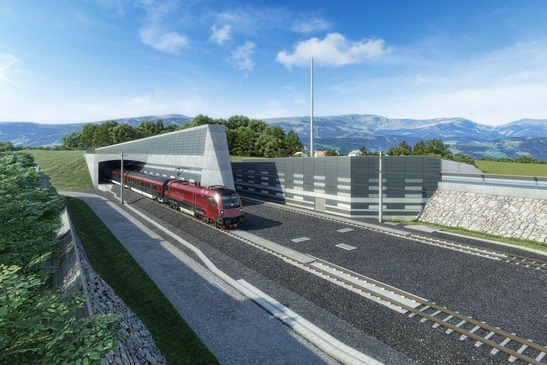
Rail expansion continues consistently and secures transport and climate turnaround
With the currently adopted framework plan 2024 - 2029, schedules and costs of current projects will be adjusted. In addition, it will even be possible to anchor further important priorities in the framework plan.
ÖBB's major projects such as the Semmering Base Tunnel, the Koralm Railway and the Brenner Base Tunnel are continuing according to plan. In addition, the focus is on expanding local transport in conurbations. In the interests of climate protection, it is also important to ÖBB to make regional trains more attractive and to push ahead with a corresponding electrification program. The further expansion of infrastructure facilities for freight transport will also be of great importance. Part of the investments will be made in digitization with a view to the future.
Exemplary new projects and focal points in the regions
The first funds are put in hand for the construction of the new Köstendorf - Salzburg line. The four-track expansion of the western line before Salzburg will enable higher capacities and thus a better range of passenger and freight services, as well as local and long-distance traffic. Also new in the framework plan are the double-track expansion of the Werndorf - Spielfeld line, as an important section in the direction of South-Eastern Europe and to the port of Koper, the double-track expansion of the Nettingsdorf - Rohr-Bad Hall section on the Pyhrn line, and two regional rail projects: The Herzogenburg - St. Pölten extension and the upgrading of the Ossiachersee train.
Rail continues to become fit for freight traffic
Programs for the construction of so-called freight train-length passing sidings have the greatest possible effect with comparatively little effort. The joint use of the same lines by freight and passenger traffic can thus be handled even more efficiently. Support measures for connecting railroads and a wave of modernization for marshalling yards also anchor the current freight traffic offensive in the framework plan.
Green energy for the green railroads of tomorrow
Another focus is on the expansion of renewable energies. The construction of further "mini-transformers" is new in the framework plan so that the electricity sustainably produced in ÖBB's own wind and solar power plants can be fed into the rail power grid. Also continuing on track are the priorities already set, such as the modernization and partial electrification of regional trains. In addition, train operations are being further digitized for greater safety and more capacity.
Investments in the existing network guarantee safety and punctuality
ÖBB is one of the safest and most punctual railroads in Europe. The prerequisite for this is the consistent maintenance of the existing network. For the maintenance (e.g. repair and fault clearance) of the existing infrastructure facilities - in addition to the 21.1 billion euros - around 4.7 billion euros have been earmarked for the period 2024-2029.
In view of the forthcoming organizational integration of the GKB infrastructure division into ÖBB-Infrastruktur AG, the infrastructure projects of Graz-Köflacher-Bahn (GKB) are also included in the framework plan for the first time, with an investment sum of around EUR 500 million and the necessary maintenance funds.
The framework plan is the planning and financing instrument for investments in the network of ÖBB-Infrastruktur AG. The legal basis for this is Section 42 of the Federal Railways Act.
The ÖBB framework plan is a presentation of the planned projects and their investment sums, which are planned for implementation within the respective 6-year period. Furthermore, the framework plan also includes the expenses for the maintenance of the rail network planned for the period.